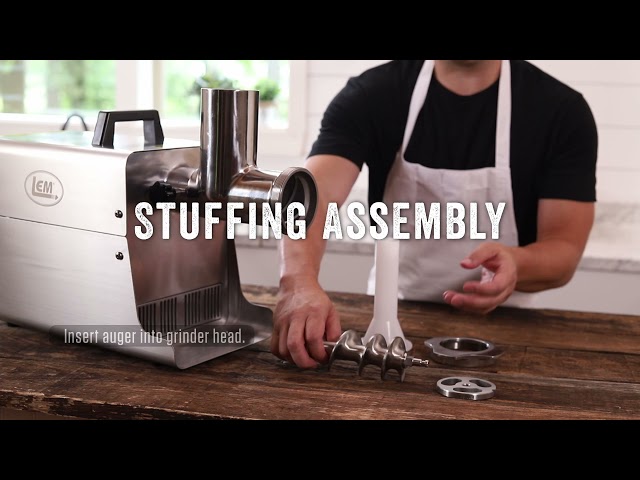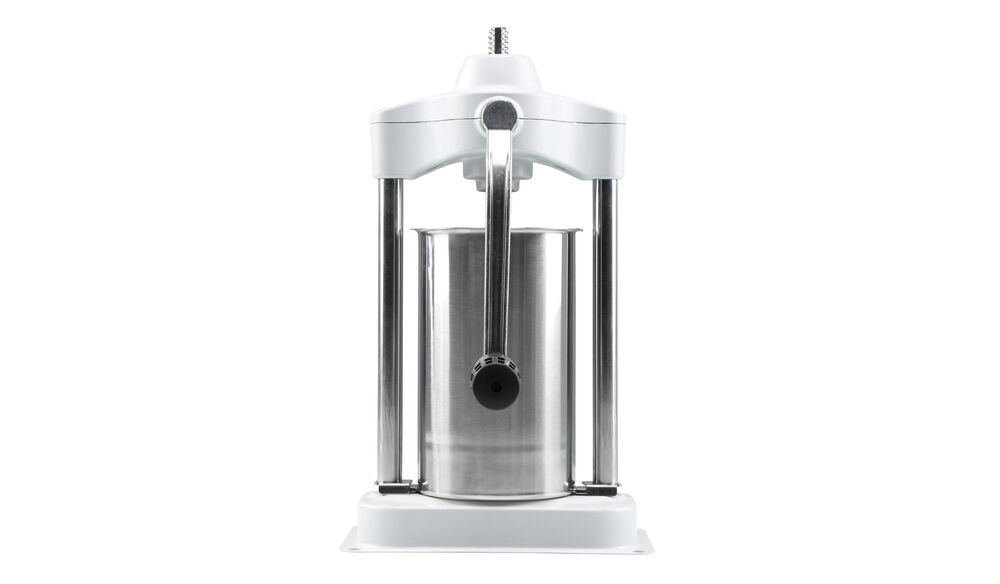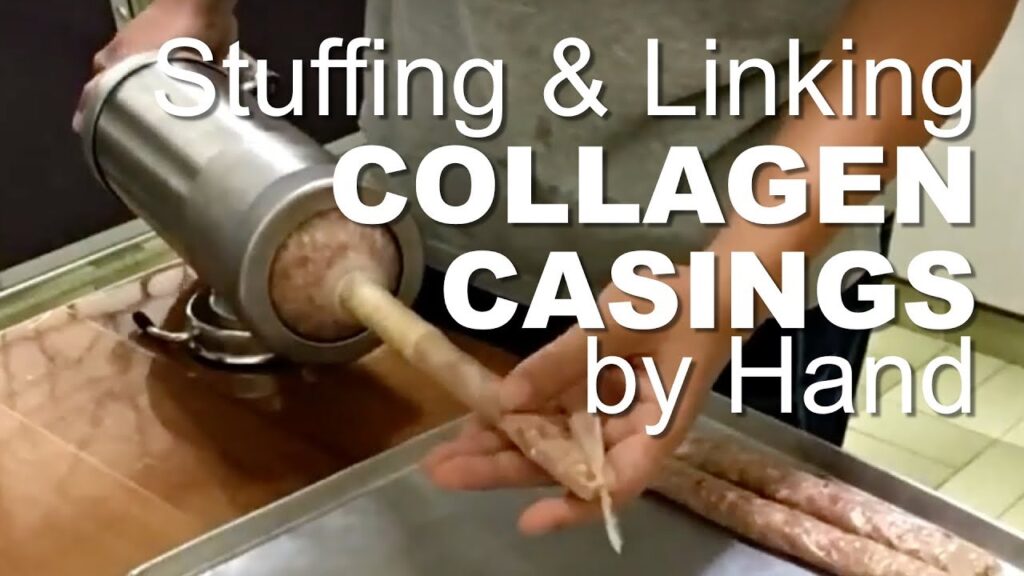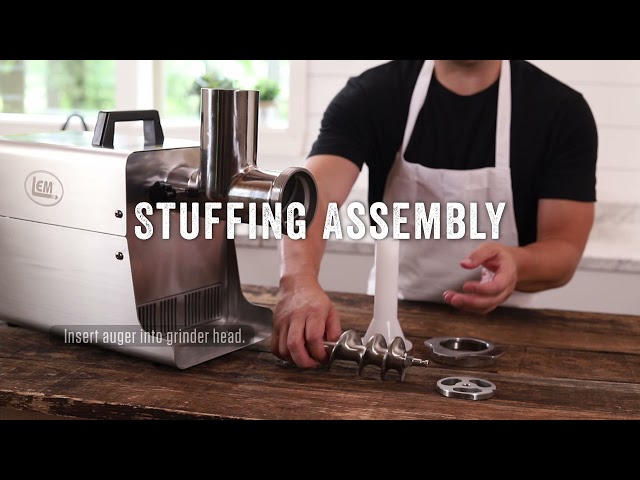To use a meat grinder to stuff sausage, you can either use a sausage stuffer attachment or a stuffing horn. A sausage stuffer is the most efficient method, while a stuffing horn is a more manual approach.
With either method, it’s important to work in small batches and keep your equipment chilled for best results. Sausage making is a time-honored tradition that has been passed down for generations. Whether you’re a seasoned pro or a beginner, using a meat grinder to stuff sausage can be a great way to make your own homemade sausages with unique flavors and textures.
We’ll explore the different methods for using a meat grinder to stuff sausage, including using a sausage stuffer attachment or a stuffing horn. We’ll also share some tips for getting the best results and making delicious, homemade sausages that your whole family will love.
Selecting The Right Meat Grinder
When it comes to stuffing sausage, selecting the right meat grinder is crucial. Whether you opt for a manual or electric grinder, there are key features to consider before making your purchase. Let’s delve into the essential factors for choosing the perfect meat grinder for your sausage stuffing needs.
Manual Vs Electric Grinders
Manual grinders are operated by hand, making them suitable for small-scale sausage making. They are typically more affordable and don’t require electricity, making them a portable option. On the other hand, electric grinders are powered by motors, providing a more efficient and faster grinding process. They are ideal for larger quantities of sausage stuffing, offering convenience and speed.
Key Features To Consider
- Motor Power: Opt for a higher wattage for electric grinders to ensure efficient grinding, especially for tougher meats.
- Grinding Capacity: Consider the amount of meat the grinder can handle at once to suit your sausage-making requirements.
- Attachments: Look for grinders with sausage stuffing attachments or compatibility with sausage stuffing kits for seamless sausage production.
- Construction: Choose durable materials such as stainless steel for longevity and ease of cleaning.
- Size and Portability: Determine the space available in your kitchen and whether you need a portable option for outdoor use.
- Price: Set a budget and compare features to find a grinder that offers the best value for your sausage-making needs.
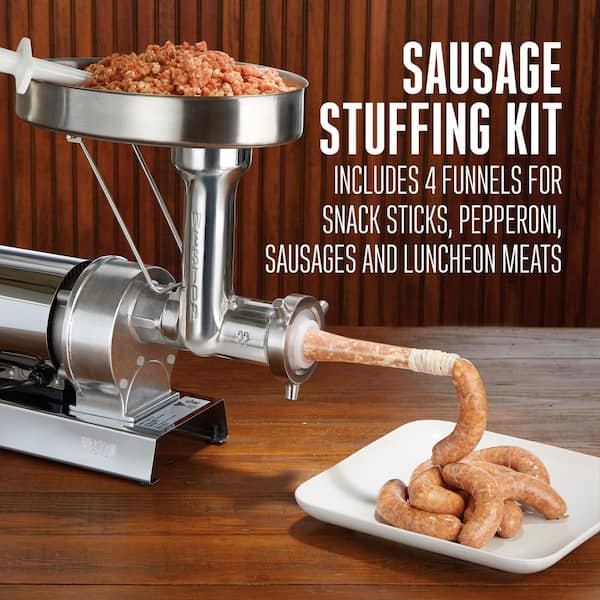
Credit: www.homedepot.com
Essential Grinder Attachments
When it comes to using a meat grinder to stuff sausage, having the right attachments is crucial for achieving the best results. Two essential grinder attachments that play a key role in the sausage stuffing process are the stuffing horn and the locking ring. Let’s delve into the specifics of each attachment to understand their importance.
Choosing The Proper Stuffing Horn
When using a meat grinder for sausage stuffing, selecting the appropriate stuffing horn is essential. The stuffing horn, also known as a sausage stuffing tube, determines the size and shape of the stuffed sausages. It’s important to choose a stuffing horn that matches the desired sausage size, ensuring that the meat is evenly and consistently stuffed into the casings.
The Role Of The Locking Ring
The locking ring is a vital component when attaching the stuffing horn to the grinder. It secures the stuffing horn in place, preventing any movement during the sausage stuffing process. This ensures that the meat is accurately and uniformly dispensed into the casings, resulting in well-formed sausages with a consistent texture.
Preparation Before Grinding
Before you start grinding meat for sausage, it’s essential to take a few preparatory steps to ensure the best results. This section will guide you through the necessary preparations, including cutting the meat and fat and chilling both the meat and equipment.
Cutting Meat And Fat
When it comes to making sausage, cutting the meat and fat into small pieces is crucial. This step ensures that the meat and fat blend together properly during the grinding process, resulting in a well-mixed and flavorful sausage.
To cut the meat and fat, use a sharp knife and make sure to remove any bones, gristle, or tough connective tissue. Cut the meat and fat into small chunks, approximately 1-inch in size. This size is ideal for grinding and will ensure that the meat feeds smoothly through the grinder without clogging.
Chilling Meat And Equipment
Chilling the meat and equipment is another essential step in preparing to grind sausage. Keeping the meat and equipment cold throughout the process helps maintain food safety and ensures that the meat grinds evenly and efficiently.
Before grinding, place the meat in the refrigerator for at least 30 minutes or until it is thoroughly chilled. Chilled meat is easier to handle and less likely to smear or become mushy during grinding.
In addition to chilling the meat, it’s important to chill the grinder and any attachments or accessories you will be using. Place the grinder parts in the freezer for about 15 minutes before grinding. This will help keep the meat cold as it passes through the grinder, preventing it from heating up and potentially compromising the quality of the sausage.
By taking the time to cut the meat and fat into small pieces and chilling both the meat and equipment, you’ll set yourself up for success when it comes to grinding sausage. These simple yet crucial steps ensure that the meat grinds smoothly, resulting in delicious and well-textured sausages.
Grinding The Meat
Learn how to use a meat grinder to stuff sausage with these simple steps. Start by grinding the meat and fat into small pieces, then chill the meat and equipment before working in small batches. Grind on the highest speed and rechill the meat before mixing.
Finally, use the food pusher to guide the meat into the hopper tube and gently press it through the attachment. Enjoy homemade sausages with ease!
Optimal Grinding Speed
When it comes to grinding the meat for sausage stuffing, it’s important to maintain an optimal grinding speed. Grinding at the right speed ensures that the meat is evenly ground and prevents it from becoming too mushy or tough.
To achieve the optimal grinding speed, it’s recommended to use a medium speed setting on your meat grinder. This setting allows the grinder to efficiently process the meat without overworking it. It’s important to avoid grinding at high speeds, as this can cause the meat to heat up and affect the texture and flavor of the sausage.
Batch Grinding Technique
Using the batch grinding technique is a great way to ensure that the meat is ground to the desired consistency for sausage stuffing. This technique involves grinding the meat in smaller batches instead of grinding it all at once.
By grinding the meat in smaller batches, you have better control over the texture and can easily adjust it to your preference. It also allows you to inspect the meat for any unwanted pieces or impurities before proceeding to the next batch.
To use the batch grinding technique, divide your meat into smaller portions and feed them into the grinder one at a time. This ensures that each batch is ground evenly and avoids overloading the grinder, which can affect the quality of the ground meat.
Remember to clean the grinder between batches to avoid cross-contamination and maintain the hygiene of the sausage.
By following these tips for grinding the meat, you can ensure that your sausage stuffing process goes smoothly and results in delicious homemade sausages. So, let’s get grinding!
Mixing And Seasoning
To stuff sausage using a meat grinder, begin by mixing and seasoning your ground meat to your taste. Once seasoned, load the mixture into the sausage stuffer attachment and start cranking the sausage casings. This technique ensures that your sausages are filled evenly and consistently, resulting in delicious homemade sausages.
Mixing and seasoning are essential steps when it comes to making sausage with a meat grinder. Adding spices and flavors is where you can get creative and experiment with different combinations. It’s important to ensure the temperature is controlled during mixing to prevent the meat from becoming too warm and losing its texture. Adding Spices and Flavors: When adding spices and flavors to your sausage, it’s important to keep in mind the ratio of seasoning to meat. A general rule of thumb is to use about 1 tablespoon of seasoning for every pound of meat. Some popular spices and flavors for sausage include paprika, garlic powder, onion powder, and fennel seed. Make sure to mix the spices and meat thoroughly to ensure an even distribution of flavor. Temperature Control During Mixing: Temperature control during mixing is crucial to ensure the sausage maintains its texture and flavor. The meat should be kept as cold as possible to prevent it from becoming too warm and losing its texture. It’s recommended to chill the meat in the freezer for about 30 minutes before grinding and mixing. Additionally, you can place the mixing bowl and attachments in the freezer to help keep them cold during the process. In conclusion, mixing and seasoning are important steps when using a meat grinder to stuff sausage. Adding spices and flavors allows you to get creative and experiment with different combinations, while temperature control during mixing ensures the sausage maintains its texture and flavor. By following these tips, you’ll be able to create delicious homemade sausage using a meat grinder.
Credit: www.lemproducts.com
Loading The Casing
Loading the casing is an essential step when using a meat grinder to stuff sausage. After grinding the meat and mixing in seasonings, attach the stuffing horn to the grinder and feed the casing onto it. As you turn on the grinder, the meat mixture will be pushed through the horn and into the casing, resulting in perfectly stuffed sausages.
Loading the Casing: Once you have your sausage mixture prepared, it’s time to start filling the casings. This can seem like a daunting task, but with the right tools and technique, it can be a breeze. The first step is loading the casing onto your meat grinder or sausage stuffer. Preparing Sausage Casings: Before you start loading the casings, it’s important to properly prepare them. Soak them in warm water for at least 30 minutes to soften them up and make them easier to work with. Once they are soaked, rinse them thoroughly to remove any excess salt or debris. Attaching Casings to the Stuffer: If you are using a meat grinder with a sausage stuffer attachment, you will need to attach the casing to the stuffer. Choose a stuffing horn that is the appropriate size for your casings and lock it into the flange on your grinder. Place a locking ring over the stuffing horn to secure it in place. If you are using a separate sausage stuffer, slide the casing onto the stuffer tube and tie a knot at the end to prevent the casing from slipping off. Be sure to leave enough casing at the end to tie off once it’s filled with sausage. Once your casing is attached to the stuffer, start filling it with sausage. Use a slow and steady pressure to ensure an even fill and avoid any air pockets. As the casing fills up, twist it into links or leave it in a continuous coil, depending on your preference. In conclusion, loading the casing is an essential step in the sausage-making process. By properly preparing the casings and attaching them to your stuffer, you can easily fill them with sausage and create delicious homemade sausages.Stuffing The Sausage
Stuffing sausage using a meat grinder is a simple process, but it requires attention to detail. Before starting, ensure that your grinder is properly set up and that the sausage casings are clean and ready. Then, attach the stuffing horn and begin feeding the meat mixture into the grinder while gently guiding the casing onto the horn.
It’s important to work slowly and carefully to avoid any air pockets or burst casings. With practice, you can create delicious homemade sausages with ease.
Feeding Meat Into The Grinder
To begin the process of stuffing sausage using a meat grinder, it’s important to first feed the meat into the grinder properly. Make sure that the meat is chilled and cut into small pieces before feeding it into the grinder. This will ensure that the meat grinds smoothly and evenly. Working with sharp tools is essential for efficient grinding.Pace And Pressure Control
When feeding the meat into the grinder, it’s crucial to maintain control over the pace and pressure. Feed the meat into the grinder at a steady and controlled pace, being careful not to overload the machine. Applying too much pressure can cause the grinder to clog or the meat to become compacted, affecting the texture of the sausage.Choosing The Right Stuffing Horn
Selecting the appropriate stuffing horn for your meat grinder is essential for successful sausage stuffing. Different sizes of stuffing horns are available, so choose one that matches the desired thickness of your sausage. Once you have chosen the right horn, lock it into the flange of the grinder securely to prevent any mishaps during the stuffing process.Using A Locking Ring
To ensure that the stuffing horn stays in place while stuffing the sausage, place a locking ring over the horn and tighten it securely. This will prevent the horn from coming loose and ensure that the sausage casing is filled evenly.Working In Small Batches
To make the sausage stuffing process more manageable, it’s recommended to work in small batches. This allows for better control and prevents the meat from becoming too warm during the grinding and stuffing process. Working in small batches also ensures that each sausage is consistent in size and texture. Remember to follow these steps carefully when using a meat grinder to stuff sausage. By feeding the meat properly, controlling the pace and pressure, selecting the right stuffing horn, using a locking ring, and working in small batches, you’ll be able to achieve perfectly stuffed sausages with ease. Enjoy the delicious results of your homemade sausages!
Credit: www.amazon.com
Twisting And Storing Sausages
After you have successfully stuffed your sausages using a meat grinder, the next step is to twist and store them properly. Twisting the sausages ensures that they hold their shape and stay intact during cooking. Proper storage is essential to maintain the quality and freshness of the sausages for longer periods.
Proper Twisting Techniques
When it comes to twisting sausages, there are a few techniques you can use to achieve the desired results:
- Start by pinching the sausage casing near the end and twist it several times in one direction.
- Continue twisting the sausages at regular intervals, alternating the direction each time to create a uniform appearance.
- Avoid twisting the sausages too tightly as it can cause the casing to break during cooking.
- Ensure that the sausages are evenly twisted along their entire length for consistent cooking.
Storage Recommendations
Once you have twisted the sausages, it’s important to store them properly to maintain their freshness and flavor. Here are some storage recommendations:
- Place the twisted sausages in airtight containers or vacuum-sealed bags to prevent air exposure.
- Label the containers or bags with the date to keep track of their freshness.
- Store the sausages in the refrigerator at a temperature below 40°F (4°C) to slow down bacterial growth.
- If you plan to store them for an extended period, consider freezing the sausages. Wrap them tightly in plastic wrap or aluminum foil before placing them in freezer-safe bags or containers.
- When thawing frozen sausages, do so in the refrigerator overnight or use the defrost setting on your microwave.
By following these twisting and storage techniques, you can ensure that your homemade sausages stay fresh and delicious until you’re ready to cook and enjoy them.
Cleaning And Maintenance
Proper cleaning and maintenance are essential for ensuring the longevity and efficiency of your meat grinder, especially when using it for sausage stuffing. By following post-use cleaning tips and maintaining your grinder, you can keep it in optimal condition for future use.
Post-use Cleaning Tips
After using the meat grinder for sausage stuffing, it’s crucial to clean it thoroughly to prevent any residue from affecting future use. Here are some post-use cleaning tips:
- Disassemble the grinder carefully to access all components.
- Use a small brush or toothpick to remove any meat particles or fat stuck in the grinder’s crevices.
- Wash all removable parts with warm, soapy water, ensuring thorough cleaning to eliminate any remaining meat or fat.
- Rinse and dry each component completely before reassembling the grinder.
- Store the grinder in a clean, dry place to prevent the accumulation of dust or moisture.
Maintaining Your Grinder For Longevity
Regular maintenance is key to prolonging the lifespan of your meat grinder. To ensure its longevity, consider the following maintenance practices:
- Regularly inspect the grinder for any signs of wear or damage, such as worn blades or clogged channels.
- Apply food-grade lubricant to the moving parts to prevent rust and ensure smooth operation.
- Sharpen the grinder’s blades as needed to maintain optimal grinding performance.
- Store the grinder in a cool, dry environment away from direct sunlight to prevent degradation of its components.
Creative Sausage Recipes
Unlock the potential of your meat grinder by exploring creative sausage recipes that will tantalize your taste buds. Whether you’re drawn to traditional flavors or eager to experiment with unique combinations, these sausage recipes are sure to elevate your culinary skills and impress your family and friends.
Traditional Sausage Variations
Delve into the rich heritage of traditional sausage variations that have stood the test of time. From the classic Italian sweet sausage to the hearty and savory bratwurst, these time-honored recipes offer a glimpse into the diverse world of sausage-making. Embrace the authentic flavors and learn the techniques that have been passed down through generations.
Experimenting With Unique Flavors
Break free from convention and embark on a culinary adventure by experimenting with unique flavors in your sausage recipes. Infuse your sausages with bold ingredients such as jalapeno, cheddar cheese, or maple syrup to create a taste sensation that is truly one-of-a-kind. With the endless possibilities for flavor combinations, unleash your creativity and let your taste buds be your guide.
Frequently Asked Questions
Can I Use My Grinder To Stuff Sausage?
Yes, you can use your grinder to stuff sausage, but a sausage stuffer is typically more efficient. Some grinders have attachments that can help with the stuffing process.
How Do You Make Sausage With A Meat Grinder?
To make sausage with a meat grinder, follow these steps: 1. Cut meat and fat into small pieces. 2. Chill the meat and equipment. 3. Grind the meat on the highest speed. 4. Rechill the meat before mixing. 5. Mix on the lowest speed.
Using a sausage stuffer is a more efficient method, but it is possible to manually stuff sausage. Remember to work with sharp tools and in small batches.
Do You Grind Meat Before Making Sausage?
Yes, grinding meat before making sausage is essential for the binding process and affects the final texture and appearance of the sausage.
Conclusion
Mastering the art of using a meat grinder to stuff sausage opens up a world of culinary possibilities. Whether you’re a seasoned chef or a novice cook, the process can be made easier by following the right techniques. With attention to detail and the right equipment, you can create delicious, homemade sausages to impress your family and friends.
